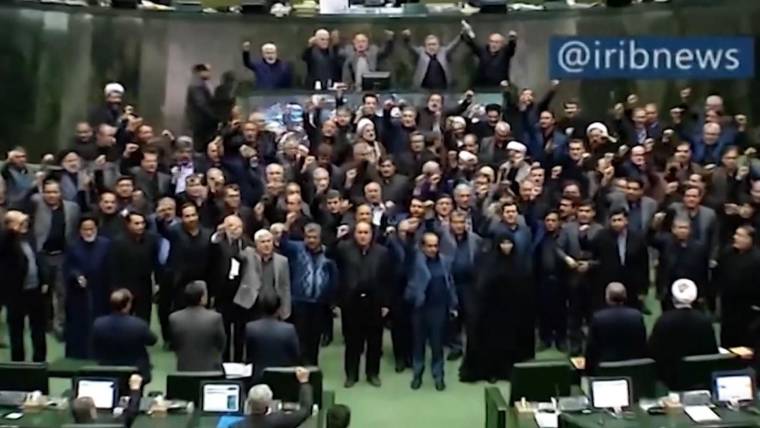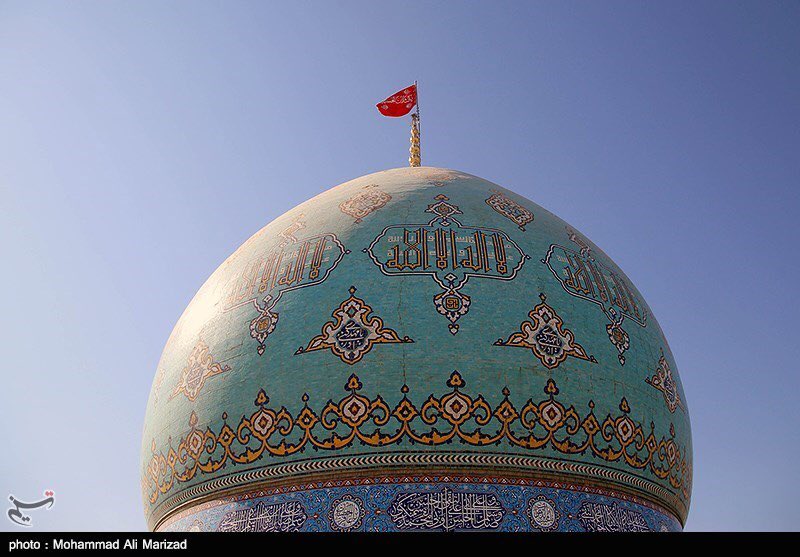Tens of thousands mourn Soleimani in Iran as Iraq parliament votes to end U.S. military presence
As the Islamic Republic laid Soleimani to rest and President Donald Trump issued new threats, Iraq's parliament voted to ask its government to end the presence of U.S. troops in the country.


Trump warns Iran against retaliating
By Ali Arouzi and Yuliya Talmazan
TEHRAN — A tide of mourners welcomed the body of Gen. Qassem Soleimani home to Iran Sunday ahead of a grand funeral for the man whose death stoked shock, anger and fears of escalation in the Middle East.
Tens of thousands packed the streets of the Iranian cities of Ahvaz and Mashhad to pay tribute to Soleimani, who was killed in a U.S. drone strike in Iraq early Friday.
They were the first stops on a grand, multi-city funeral procession for one of the country's most powerful military and political figures.
 Iranians march during the procession of general Qassem Soleimani's coffin in Mashhad on Jan. 5, 2020.Mohammad Taghi / AFP - Getty Images
Iranians march during the procession of general Qassem Soleimani's coffin in Mashhad on Jan. 5, 2020.Mohammad Taghi / AFP - Getty Images
As the Islamic Republic laid Soleimani to rest and President Donald Trump issued new threats, the future of America's presence in the region came into focus.
Iraq's parliament voted Sunday to ask its government to end the presence of U.S. troops in the country.
Meanwhile the leader of Lebanon’s Hezbollah group said that U.S. bases, warships and soldiers in the Middle East were now fair targets. Hassan Nasrallah said evicting the American military from the region was now a priority.
Ali Arouzi@aliarouzi
One of Qassem Soleimani’s main objectives was to expel the US from Iraq. Ironically his death seems to have sped up that process.
166 people are talking about this
As the leaders of Iran and its allies vowed to avenge Soleimani's death, Trump appeared to show no desire to ease the tensions that his strike had sent soaring.
The president issued new threats late Saturday, saying the U.S. would attack 52 sites important to the country and its culture if Tehran retaliates against Americans or U.S. assets.
Iran's Foreign Minister Mohammad Javad Zarif accused Trump of threatening a "war crime," while the country's communications minister called him "a terrorist in a suit."

MEET THE PRESSPompeo defends Soleimani strike, says U.S. expects 'a little noise' in Iran's response
Soleimani's death has dominated life in Iran since Friday.
Images depicting the general have been plastered across the country while state TV has been covering his death non-stop, with all channels displaying a black stripe in the corner of the screen as a sign of mourning.
On Sunday, state TV showed his casket wrapped in an Iranian flag being unloaded from a plane as a military band played.
The casket then moved slowly through streets choked with mourners wearing black, beating their chests and carrying posters with Soleimani's portrait.
Demonstrators also carried red Shiite flags, which traditionally both symbolize the spilled blood of someone unjustly killed and call for their deaths to avenged.
Ali Arouzi@aliarouzi
Very very unusual to see a red flag flying over holy mosque of Jamkaran in Qom, Iran‘s holiest city. It’s is almost always blue. The red flag symbolises revenge.
2,003 people are talking about this
The main funeral ceremony will be held in Tehran on Monday, where Iran’s Supreme Leader Ayatollah Khamenei will lead prayers for the general.
On Tuesday, Soleimani will be buried in his hometown of Kerman in southeast Iran.
Thousands had gathered in Iraq Saturday to mourn Soleimani and militant leaders killed in the airstrike, chanting "Death to America, death to Israel" as they marched.
Baghdad has been closely allied with both Tehran and Washington, but its relationship with the U.S. was now in doubt.
Friday's deadly drone strike near the Iraqi capital's international airport capped weeks of escalation that saw protesters linked to an Iran-backed militia group storm the U.S. embassy.


A conflict with Iran could get ‘very heated, very, very fast,’ analyst says
Shortly before Sunday's vote in parliament, the U.S.-led coalition said it had paused training and support of Iraqi security forces due to repeated rocket attacks on U.S. bases.
The U.S. has about 5,000 troops in Iraq in order to combat the Islamic State militant group, a fight Soleimani is credited with aiding.
A further 3,000 troops were dispatched to the region Friday in the wake of Soleimani's death and the broader unrest.
As a leader of an elite Iranian military and intelligence unit, Soleimani was the architect of Tehran’s overseas clandestine and military operations, accused of controlling proxy militias across the region, including ones in Iraq, Lebanon and Syria.
He was considered the most powerful intelligence operative in the Middle East for more than two decades.

PROFILEWho was the Iranian 'shadow commander' killed in a U.S. airstrike?
In the weeks prior to Soleimani’s killing both Iran and Iraq were rocked by anti-government protests that prompted swift and deadly government crackdowns.
Sparked in November by hikes in gasoline prices, the Iranian demonstrations quickly expanded to cover calls for more political freedom and other issues.
Widespread economic discontent has gripped the country since May last year, when Trump imposed crushing sanctions after unilaterally withdrawing from Tehran’s nuclear deal with world powers.
Iran’s foreign ministry said Sunday officials would meet to discuss their next step away from the nuclear deal, adding that it would be an even bigger step than initially planned given recent events.
Three days of national mourning were declared in the wake of Soleimani's death, while the world held its breath for Iran's response.
Ali Arouzi reported from Tehran, and Yuliya Talmazan from London.











Post a Comment